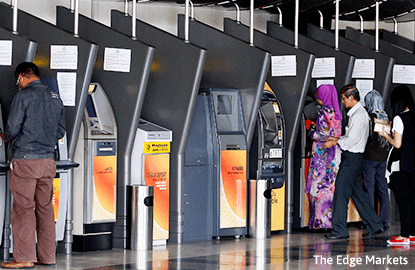
This article first appeared in Corporate, The Edge Malaysia Weekly, on July 18 - 24, 2016.
MALAYSIAN banks with exposure to China are keeping a watchful eye on the quality of their loans in that foreign market as the ballooning non-performing loans there have passed the RMB2 trillion (US$299.21 billion) mark at the end of May. The NPL ratio climbed to 2.15% of total bank lending, up 0.16 percentage points from the start of the year.
Banks in China could be facing the highest level of bad loans since 2004, and officials with the country’s regulators say the situation is unlikely to improve in the short term.
Industry observers and bankers in Malaysia say concern is rising among local banks over exposure to China as the NPL bubble continues to expand.
“Of course, local banking groups are looking into it and we are keeping a watchful eye on our China loans. We are doing stress tests, but note that the stress testing is on the total group loan book across all markets we are in and that includes the Chinese loans,” says a C-level banker with a local banking group.
“It depends on what kind of exposure the banking group has to the Chinese market. I think people are nervous, more so recently because of the defaults by some state-owned enterprises there, and the economic growth numbers have nearly halved compared with about 10 years ago ... But we should remember that even though the growth numbers have halved, the absolute number is still very big,” he says.
A banking analyst with a foreign research house says: “The concern is more about the corporate exposure in China for local banks, rather than retail exposure. While the Chinese loan segment may be smaller for most banks here, compared with markets such as Indonesia and Singapore, the banks should keep an eye on the quality of the loans in the Chinese market.”
Some Malaysian banks have a direct presence or associate stakes in banks in China. These include the three largest banking groups in the country — Malayan Banking Bhd (Maybank), CIMB Group Holdings Bhd and Public Bank Bhd — as well as the fifth largest banking group Hong Leong Bank Bhd (HLBB).
Banks with a larger direct presence in China and Hong Kong, such as Maybank and Public Bank, appear to have seen a bigger increase in their impaired loans in these markets recently than CIMB and HLBB, which have a smaller direct presence and associate stakes in Chinese banks.
According to Maybank’s FY2015 annual report, impaired loans from China rose to RM124.6 million in FY2015 from RM8.8 million a year earlier, while impaired loans in Hong Kong jumped to RM848.1 million from RM15.9 million in the same period.
“Maybank’s Greater China performance was affected by loan impairments, attributed in part to the prevailing market conditions and credit exposures to vulnerable sectors, including commodities. We, however, remain vigilant and asset quality management continues to be our key focus with an ongoing review of our risk posturing and risk appetite, including target sectors and customer segments,” says Datuk Amirul Feisal Wan Zahir, group chief financial officer of Maybank, in a written reply to The Edge.
“China, as a market, is significant in the long term and our strategies reflect this, as demonstrated by the recent opening of our Shenzhen branch. Maybank remains focused on growing our China franchise in a sustainable and responsible way. However, we continue to be vigilant over asset quality, in line with current market sentiments.”
Public Bank saw its impaired loans and financing in China and Hong Kong increase to RM104.9 million in FY2015 from RM62.3 million a year earlier.
According to CIMB’s FY2015 annual report, its impaired loans in China dropped to RM64.9 million in FY2015 from RM95.8 million a year earlier.
A CIMB spokesman says in a written reply to The Edge: “Going forward, we do not expect the group’s NPL for China to increase as most of our business in China is currently focused on facilitating our clients’ entry into the China market.”
HLBB did note in its March 31 quarterly results that its international banking segment recorded a lower pre-tax profit of RM95.6 million for the third quarter ended March 31 this year, compared with RM107.4 million a year ago, due to a lower share of profit from its associate company in China.
HLBB adds that the lower profit from its 20%-owned Bank of Chengdu was due to an increase in impairment provisioning and the unanticipated lending rate cut by China’s central bank as a measure to promote economic growth.
When contacted on this, HLBB says it is unable to comment as it is in the blackout period for the financial year end. Public Bank did not respond to The Edge’s email on this matter.
The economy in China has been slowing since last year, expanding at 6.9% — the lowest in 25 years — in 2015, compared with 7.4% in 2014. Economists expect it to decelerate further this year, slowing to the mid-6% range at the bottom end of the Chinese government’s target of 6.5% to 7%. The world’s second largest economy expanded at its highest rate of over 14% in 2007.
Maybank has two branches in Hong Kong and four in China — one each in Shanghai, Beijing, Kunming and Shenzhen. The last was opened in April. Public Bank has 32 branches in Hong Kong and three in Shenzhen.
CIMB and HLBB also have a toehold in the Chinese banking market through their associate investments in Chinese banks. CIMB has an 18.21% stake in Bank of Yingkou while HLBB has 20% equity interest in Bank of Chengdu. CIMB has a branch each in China and Hong Kong while HLBB has a branch in Hong Kong.
Save by subscribing to us for your print and/or digital copy.
P/S: The Edge is also available on Apple's AppStore and Androids' Google Play.